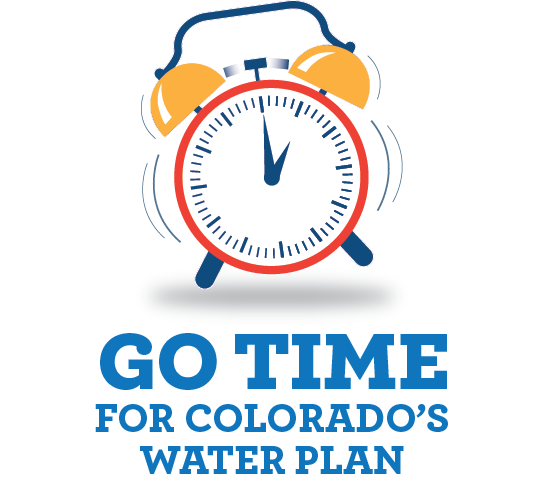By Nelson Harvey, excerpts pulled from an originally published in the Winter 2016 issue of Headwaters magazine
 When Gov. John Hickenlooper triumphantly hoisted the final water plan at a mid-November ceremony in Denver, the hundreds of Coloradans who contributed to its formation paused to take a congratulatory breath. Yet even then, questions were swirling about how the voluntary plan would work—how the state’s utilities, businesses, advocacy groups and individual water users would internalize its recommendations and take responsibility for its goals—and whether they would, by the plan’s own measurement of success, be able to close the municipal water supply and demand gap without compromising other values.
When Gov. John Hickenlooper triumphantly hoisted the final water plan at a mid-November ceremony in Denver, the hundreds of Coloradans who contributed to its formation paused to take a congratulatory breath. Yet even then, questions were swirling about how the voluntary plan would work—how the state’s utilities, businesses, advocacy groups and individual water users would internalize its recommendations and take responsibility for its goals—and whether they would, by the plan’s own measurement of success, be able to close the municipal water supply and demand gap without compromising other values.
Here, we turn those questions on one of the plan’s nine defined measureable outcomes: water conservation.
 Water conservation: Stretch now to avoid strain later
Water conservation: Stretch now to avoid strain later
The water plan sets an ambitious “stretch” goal of conserving 400,000 acre-feet of municipal and industrial water annually by 2050. That level of conservation would go a long way toward closing Colorado’s projected gap between water supply and demand—about 560,000 acre-feet per year in 2050 under a business-as-usual paradigm—and sharply reduce the need for new water supplies procured through controversial measures like new transbasin diversions or the dryup of irrigated agriculture.
Drew Beckwith, water policy manager for Western Resource Advocates, says achieving the goal will mean reducing per-capita water demand by about 1 percent per year between 2010 and 2050, so that each Coloradan’s demand 35 years from now will be 35 percent lower than it is today. “We’ve been achieving that rate of conservation over the last 15 years in Colorado, and water providers have told the state that they plan to continue doing it in the future, so there is lots of evidence that it’s possible,” Beckwith says.
Getting there will require long-term collaboration between state agencies and water utilities and their customers, whether those customers are motivated by their environmental ethos or a hefty water bill. To reach the goal, utilities will have to implement measures outlined in the “high conservation” scenario laid out in the 2010 Statewide Water Supply Initiative report by the Colorado Water Conservation Board (CWCB), the agency that oversaw the water plan’s creation.
That scenario, which CWCB water conservation specialist Kevin Reidy calls “difficult but not impossible” to achieve, involves things like at least half of all utilities introducing individual water budgets for their customers, where water use targets are set and financial penalties imposed for above-average use. Other possibilities: Between 70 and 100 percent of municipalities might adopt conservation-oriented plumbing and building codes, and at least half of the water-hungry turf in the state might be replaced with low water-use plantings.
Much of the responsibility will rest on the shoulders of water providers and customers, but the water plan pledges that the state will also take steps to encourage conservation. One is to make comprehensive water resource planning by utilities a pre-condition of any state support of—or funding for—new water projects, thus requiring utilities to show they’re on track with conservation before receiving state funds. (Although utilities delivering at least 2,000 acre-feet of water per year are already required to submit conservation plans to the CWCB, the new mandate would require they integrate those plans with other aspects of their operations.)
“We believe that we can use incentives to push people in the right direction,” says Jacob Bornstein, CWCB program manager for the basin roundtables and Interbasin Compact Committee.
The water plan also recommends exploring a new state law that would require all outdoor irrigation equipment sold in Colorado to meet federal WaterSense efficiency standards.
Compared to the challenge of achieving the conservation goal, keeping tabs on progress will be relatively easy, thanks to a 2010 state law—House Bill 1051—requiring water providers (those that sell 2,000 acre-feet of water annually) to report their annual water use and conservation data to the CWCB to aid in water supply planning.
“Going forward we’ll have data that we can use to monitor our progress,” says Beckwith. “Also, if individual utilities are doing well with conservation we would expect them to publicize that. Maybe through a combination of record keeping and self-promotion, we will get there.”

 Print
Print
Reblogged this on Coyote Gulch.
This is so simple. Damn off the Gunnison and Colorado at Grand Junction, Colorado. The railroad will go around the base of the Bookcliffs, they already agreed 10 years ago, and the petrocliffs can be moved to a museum with the proper cutting tool that they use in mines, and the peach farmer can be bought out. Then, let the right amount of needed water go down the river, and we have control. It eliminates a bunch of discussion, worry and it improves the western slope economy and agriculture. Amen